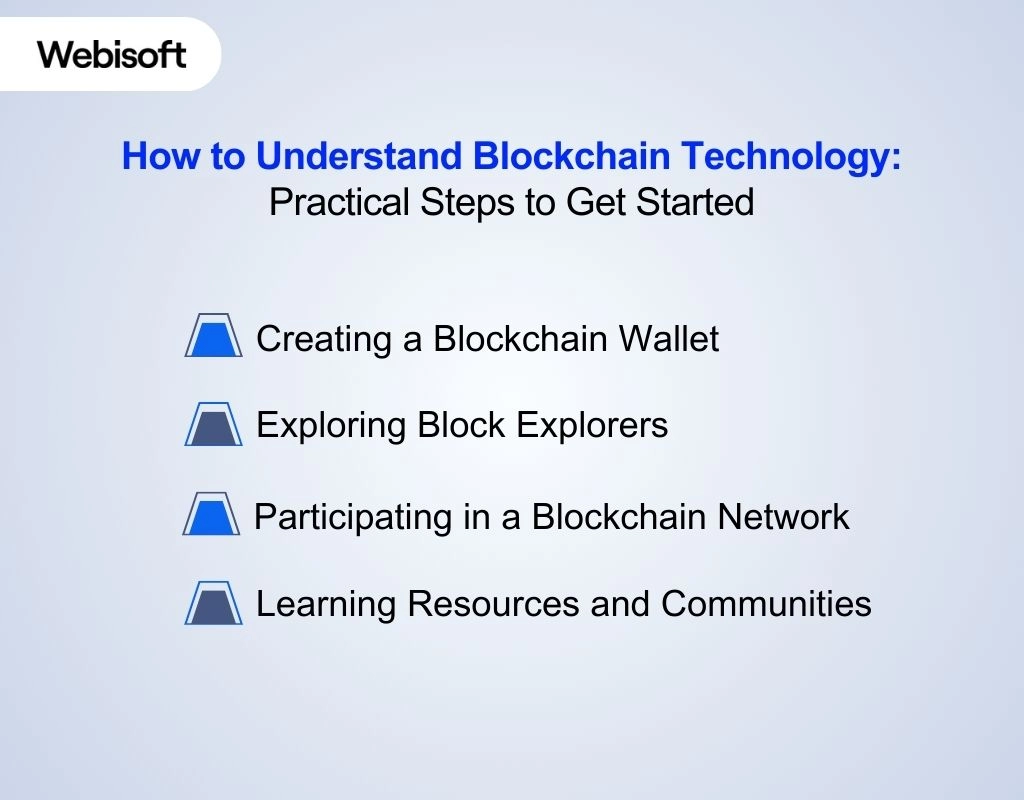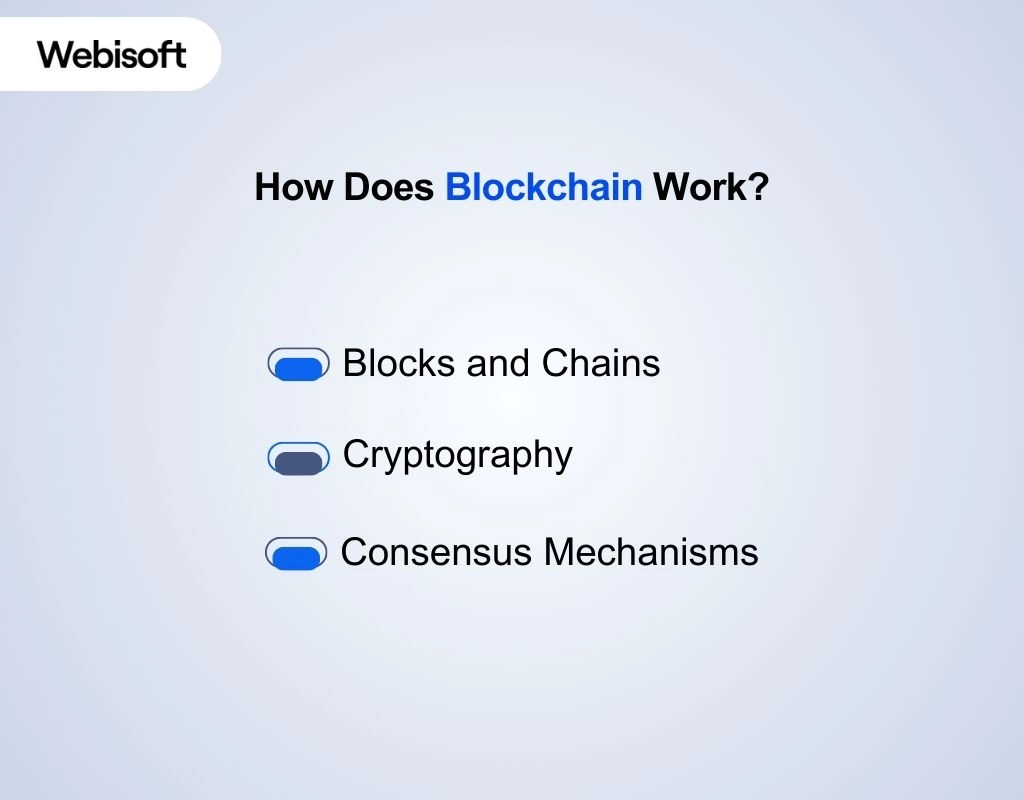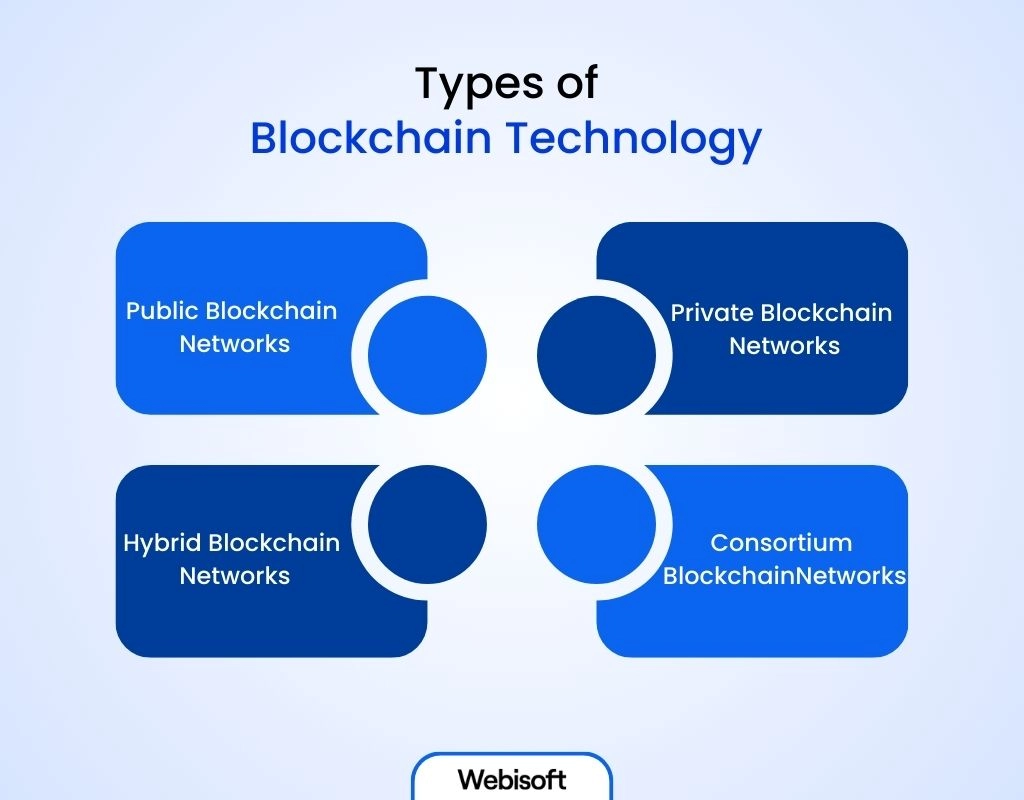How To Understand Blockchain Technology?
- BLOG
- Blockchain
- October 19, 2025
Blockchain is more than hype, but most people struggle to understand what it actually does. Technical jargon, endless use cases, and misconceptions create confusion and doubt. Blockchain is a decentralized digital ledger that offers trust, security, and automation, redefining how data is stored and verified. This article walks you through how to understand blockchain technology for beginners, from its architecture to real-world applications.
Contents
- 1 What is Blockchain Technology?
- 2 How to Understand Blockchain Technology: Practical Steps to Get Started
- 3 How Does Blockchain Work?
- 4 Unlock the power of blockchain with Webisoft today!
- 5 What are the Features of Blockchain Technology?
- 6 Types of Blockchain Technology
- 7 What are The Advantages and Limitations of Blockchain Technology
- 8 Drawbacks of Blockchains
- 9 What is Blockchain as a Service?
- 10 Bitcoin vs. Blockchain: Find the Core Difference
- 11 Blockchain Usage In Different Industries
- 12 How Webisoft Streamlines Your Blockchain Development Journey
- 13 In Closing
- 14 Frequently Asked Questions
What is Blockchain Technology?
Blockchain technology is a decentralized and cryptographically secured method of recording data across multiple nodes. At its core, it functions as a distributed digital ledger, where transactions are logged in structured data blocks. These blocks are chronologically linked, forming an immutable chain. Each block contains a timestamp, a unique cryptographic hash, and the hash of the previous block. NIST guidance for enterprise deployments stresses that the overall system such as node software, key management, network security, and consensus design. All must follow rigorous architectural and cryptographic best practices to maintain this integrity at scale.
Blockchain Tech in Plain English
Picture a digital notebook that everyone can see but nobody can secretly erase. Each new page (a “block”) lists recent events and carries the unique code of the page before it. Thousands of computers automatically keep identical copies and must all agree before a page is added. Because the pages are chained by codes, altering an old one would break every copy and be instantly rejected. That shared, tamper‑evident notebook is what we call a blockchain.
How to Understand Blockchain Technology: Practical Steps to Get Started

Creating a Blockchain Wallet
To start with blockchain, create a wallet, which acts as your digital bank account for storing cryptocurrencies or assets. Wallets can be software-based (mobile, desktop, or web) or hardware for added security. You’ll generate a private key and seed phrase for ownership and security. Keep the seed phrase private and losing it means losing access to your wallet.
Exploring Block Explorers
Once your wallet is set up, use block explorers to view and verify transactions in real-time. These tools display transaction details such as amounts, addresses, timestamps, and confirmation statuses. For example, Etherscan tracks Ethereum transactions, while Blockchain.com tracks Bitcoin. Block explorers provide transparency, showing how transactions are recorded and processed on the blockchain.
Participating in a Blockchain Network
To gain deeper blockchain knowledge, start by making test transactions on testnets, which simulate real networks without financial risk. As you advance, interact with smart contracts and participate in Proof of Stake (PoS) networks by staking tokens to earn rewards. Running a node also offers hands-on experience of blockchain’s decentralized operations and its network validation process.
Learning Resources and Communities
Blockchain is complex and constantly evolving. Online courses on platforms like Coursera, Udemy, and Binance Academy offer valuable learning paths. Official documentation from Bitcoin.org and Ethereum.org is also helpful. Join forums like Reddit or Stack Exchange and follow news sites like CoinDesk to stay up-to-date. Engaging with communities will expand your knowledge and connect you with the blockchain world. As you explore blockchain, Webisoft is here to guide you with expert blockchain development services.
How Does Blockchain Work?
 In the process of how to understand blockchain technology, let’s go deeper with understanding its working mechanism. Three foundational elements power its functionality:
In the process of how to understand blockchain technology, let’s go deeper with understanding its working mechanism. Three foundational elements power its functionality:
Blocks and Chains
Each transaction on a blockchain is grouped into a block. That block holds a set of verified data, a timestamp, and a unique identifier known as a cryptographic hash. It also stores the hash of the previous block, creating a permanent link. This connection forms a sequential chain of blocks. Once a block is added, it becomes nearly impossible to modify any prior record. This structure ensures data immutability and enhances the integrity of distributed records in systems such as supply chain platforms.
Cryptography
Cryptography secures every transaction on the blockchain. It uses public key infrastructure (PKI) to enable identification and authentication without ultimate privacy. Each user has a public key and a private key to encrypt and decrypt data. Digital signatures verify the sender’s identity and ensure that data remains unaltered. These cryptographic processes are critical to confidentiality and trust in blockchain-based platforms. It is especially in health information exchanges and secure voting systems.
Consensus Mechanisms
A blockchain network reaches an agreement through a consensus mechanism. This process ensures that all nodes validate and agree on the state of the ledger before adding new data. Popular methods include Proof of Work (PoW), Proof of Stake (PoS), and Practical Byzantine Fault Tolerance (PBFT). Each method varies in efficiency, energy use, and risk tolerance.
Unlock the power of blockchain with Webisoft today!
Book a free consultation – Learn, build, and scale secure blockchain solutions effortlessly.
What are the Features of Blockchain Technology?
 Blockchain technology has become a focal point of innovation due to its distinct features. These characteristics are what make blockchain stand out:
Blockchain technology has become a focal point of innovation due to its distinct features. These characteristics are what make blockchain stand out:
1. Decentralized Ledger
In blockchain, the network operates without a central authority. Each participant stores an identical copy of the ledger, making the system more resilient. This decentralized structure prevents data manipulation, downtime, or single points of failure.
2. Transparency & Shared Visibility
The blockchain provides full visibility to all participants. Every transaction is recorded on a public ledger that anyone can access. This openness promotes trust between parties and eliminates information asymmetry, benefiting businesses and consumers alike.
3. Immutability
Once data is added to the blockchain, it becomes immutable. Each block is cryptographically linked to the previous one, making tampering nearly impossible. This guarantees the accuracy of transaction records, which builds trust in the system over time.
4. Cryptographic Security
Blockchain uses robust cryptographic techniques to protect data. Each transaction is encrypted using public and private keys, securing the flow of information. This method significantly reduces the risk of unauthorized access or data breaches, safeguarding sensitive information.
5. Consensus Rules
Blockchain networks rely on consensus mechanisms to verify transactions. These algorithms, such as Proof of Work or Proof of Stake, ensure agreement among participants on transaction validity. This decentralized validation process makes the system more secure and trustworthy.
6. Programmable Logic (Smart Contracts)
Smart contracts are digital agreements executed automatically when predefined conditions are met. They reside on the blockchain and execute transactions without intermediaries. This reduces human error, speeds up processes, and cuts costs by eliminating third-party involvement.
7. Traceable Provenance
Blockchain provides a complete, transparent record of an asset’s journey. You can trace the origin, movement, and ownership of products in real-time. This feature is especially valuable in industries like supply chain management, where verifying the authenticity of goods is critical.
8. Decentralized Applications (DApps)
Blockchain supports decentralized applications (DApps) that run on peer-to-peer networks, rather than centralized servers. These applications offer more privacy and security since they don’t rely on a central point of control.
9. Tokenization
Blockchain allows the creation of digital tokens to represent assets. These tokens can be used to represent anything from cryptocurrencies to real-world assets like real estate or intellectual property, offering greater liquidity and fractional ownership.
Types of Blockchain Technology
 Blockchain systems are not one-size-fits-all. They differ in access control, governance, and scalability.
Blockchain systems are not one-size-fits-all. They differ in access control, governance, and scalability.
1. Public Blockchain Networks
Public blockchains are fully open and permissionless. Anyone can join the network, validate transactions, or create new blocks. Bitcoin and Ethereum are leading examples of this model. They promote transparency and censorship resistance. However, public blockchains often face scalability and energy-efficiency challenges. Their structure supports the working of blockchain in decentralized finance, identity systems, and open innovation ecosystems.
2. Private Blockchain Networks
Private blockchains are controlled by one organization. Only verified participants can access and validate transactions or view records. These blockchains are often used for internal business processes. Private chains offer faster speeds and greater privacy but sacrifice decentralization. They’re commonly used in supply chain tracking, audit logs, and compliance-focused industries, where strict control over data access is essential.
3. Hybrid Blockchain Networks
Hybrid blockchains combine elements of both public and private networks. A company can use a private blockchain for internal processes while linking selected data to a public chain for verification. This model balances transparency with confidentiality. It’s particularly useful in healthcare systems, government services, and inter-agency data coordination. Here, selective disclosure is required without compromising blockchain technology advantages.
4. Consortium Blockchain Networks
Consortium blockchains are governed by a group of organizations instead of one. These semi-decentralized models allow multiple stakeholders to operate a shared platform with joint governance. They support trusted collaboration between entities like banks or logistics providers. Use cases include interbank settlements, customs clearance, and cross-border compliance as supported by the World Economic Forum’s blockchain toolkit.
What are The Advantages and Limitations of Blockchain Technology
 Blockchain technology offers significant improvements in data security, operational efficiency, and system transparency. However, like any emerging technology, it comes with trade-offs. Let’s disclose all its pros first:
Blockchain technology offers significant improvements in data security, operational efficiency, and system transparency. However, like any emerging technology, it comes with trade-offs. Let’s disclose all its pros first:
Advanced Security
Blockchain’s use of public key cryptography, cryptographic hashing, and consensus algorithms. This makes it highly secure against tampering and unauthorized access. Each transaction is time-stamped and verifiable, reducing fraud risk. This architecture is especially important in financial networks and government registries, where data integrity is non-negotiable. Security is further enhanced through multi-party validation and immutable storage.
Improved Efficiency
By eliminating intermediaries and automating verification steps, blockchain streamlines processes across industries. It enables near real-time reconciliation of data between parties, reducing manual labor and paperwork. In sectors like global trade and asset tracking, blockchain reduces redundancy, shortens processing time, and improves coordination.
Faster Auditing
Blockchain keeps a tamper-proof, chronological record of all activity. This allows auditors to trace transactions without delays or manual backtracking. Data is accessible in real-time and permanently archived. This supports regulatory compliance, especially in finance and pharmaceuticals. Public institutions.
Cost Reductions
Blockchain lowers costs by automating transactions, reducing human error, and cutting third-party fees. Smart contracts further minimize legal and administrative expenses. This is most impactful in cross-border settlements, insurance claims, and procurement systems. As processes become leaner, organizations report direct savings and improved cost predictability, demonstrating clear blockchain technology advantages at scale.
Decentralization
Decentralization removes single points of control, making systems more resilient to failures and cyber threats. Every participant shares responsibility for maintaining and validating the ledger. This design supports network transparency and aligns with democratic governance models. It’s particularly relevant in projects focused on public service delivery and civic participation, where trust and accountability are essential.
Efficient Transactions
Transactions on blockchain are peer-to-peer, reducing settlement times from days to minutes. Combined with consensus mechanisms, this creates trust without needing central authorities. Industries like energy trading, peer-to-peer lending, and digital asset exchanges benefit from this speed. The working of blockchain in these areas improves liquidity, reduces disputes, and promotes seamless interactions.
Drawbacks of Blockchains
 Despite its strengths, blockchain technology has critical limitations that can hinder adoption. These challenges include high implementation costs, data inefficiencies, legal ambiguity, and regulatory hurdles.
Despite its strengths, blockchain technology has critical limitations that can hinder adoption. These challenges include high implementation costs, data inefficiencies, legal ambiguity, and regulatory hurdles.
Technology Cost
Developing and maintaining a blockchain infrastructure requires substantial investment. Costs include setting up consensus mechanisms, securing the network, and maintaining computational power.
Speed and Data Inefficiency
Blockchains, especially public ones, are slower than centralized systems. Transaction throughput is often limited by consensus processes and block size.
Illegal Activity
The pseudonymous nature of blockchain can be exploited for illegal use. Without strong identity verification, it becomes harder to trace transactions linked to money laundering, fraud, or illicit trade. Agencies like Europol and the FATF have raised concerns about the misuse of decentralized platforms.
Regulation
Blockchain operates in a fragmented legal landscape. Different countries enforce different rules, creating compliance challenges for cross-border services. The lack of unified frameworks impacts adoption in financial services, healthcare, and data privacy.
Data Storage
Blockchain isn’t designed for handling large volumes of data. Every node replicates the full ledger, increasing the storage burden as networks scale. This model creates tension between transparency and performance.
What is Blockchain as a Service?
Blockchain as a Service (BaaS) is a cloud-based solution that allows businesses to build, host, and manage blockchain applications without developing the infrastructure from scratch. Think of it like renting a fully set-up blockchain environment. Instead of spending time and money on building everything from zero, businesses can use ready-made tools to create and manage blockchain apps more easily. BaaS providers handle the technical setup, system updates, security, and network management in the background. This is especially helpful for companies that don’t have in-house blockchain experts but still want to benefit from use cases like supply chain tracking, digital identity, or secure data sharing. All the complex work happens behind the scenes, so your team can focus on building great user experiences and getting real business value. At Webisoft, we provide specialized blockchain development services that streamline blockchain adoption, from initial planning to deployment and beyond. We help businesses innovate faster, focusing on the strategic aspects while handling the technical complexities.
Bitcoin vs. Blockchain: Find the Core Difference
Bitcoin and blockchain are often confused, but they serve different purposes. Blockchain is the underlying technology, while Bitcoin is one of its most well-known applications.
| Factor | Blockchain | Bitcoin |
| Definition | A decentralized digital ledger that records and secures data across a network of computers. | A cryptocurrency that uses blockchain to record and verify peer-to-peer financial transactions. |
| Purpose | Designed to store any type of data transparently and securely, used across industries. | Created specifically as a digital currency to bypass traditional banking systems. |
| Use Cases | Applied in supply chains, identity systems, healthcare, finance, and public records. | Used primarily for financial transactions, investment, and decentralized payments. |
| Governance Model | Can be public, private, hybrid, or consortium depending on the use case. | Maintained by a decentralized network of miners using Proof of Work. |
| Development Flexibility | Developers can build custom solutions tailored to regulatory or business needs using various consensus models. | Fixed protocol, limited flexibility—changes require community-wide consensus and are often slow to implement. |
Blockchain Usage In Different Industries
Blockchain is making waves across industries that rely on trust, transparency, and data integrity. If you’re wondering how to understand blockchain technology, it’s the key to identifying its potential in various areas:
- Banking and Finance: Used for real-time settlements, fraud detection, and compliance. Enhances transparency and lowers transaction costs in cross-border banking systems.
- Currency: Supports digital currencies by securing transactions, preventing double-spending, and enabling peer-to-peer financial networks without centralized intermediaries.
- Healthcare: Secures electronic medical records, ensures traceability of pharmaceuticals, and supports data sharing between authorized providers in compliance with health data standards.
- Property Records: Improves land registry accuracy and prevents fraud through immutable transaction logs tied to ownership and title verification processes.
- Cybersecurity: Protects sensitive data using cryptographic frameworks, access control layers, and decentralized identity verification for secure system architecture.
- Logistics: Enables real-time supply chain tracking, inventory monitoring, and verification of goods origin to ensure integrity and reduce counterfeiting.
- NFTs: Provide proof of ownership for digital assets. Blockchain guarantees authenticity, transferability, and scarcity for NFTs across art, gaming, and entertainment sectors.
- Insurance: Automates claims processing through smart contracts and enhances fraud prevention with auditable policy records and time-stamped transactions.
How Webisoft Streamlines Your Blockchain Development Journey
 At Webisoft, we streamline your blockchain development process from start to finish, ensuring a smooth and efficient journey. Our expert team works closely with you to understand your unique requirements, offering customized solutions that align with your business goals. Here’s how we make blockchain adoption simple:
At Webisoft, we streamline your blockchain development process from start to finish, ensuring a smooth and efficient journey. Our expert team works closely with you to understand your unique requirements, offering customized solutions that align with your business goals. Here’s how we make blockchain adoption simple:
Clear Planning and Strategy
We start with a deep consultation and understand your business needs. Our team crafts a detailed plan, identifying the most effective blockchain strategy for your goals. This ensures every decision is purposeful and guided.
Seamless Integration
We make blockchain integration hassle-free. Our solutions are designed to integrate smoothly with your existing systems, ensuring that you don’t face disruptions during the transition. This seamless connection boosts efficiency without technical headaches.
Custom Blockchain Development
Every business is unique, and so are our blockchain solutions. We build custom systems tailored to your needs, focusing on security, scalability, and performance. This ensures your blockchain infrastructure is future-ready and adaptable as your business grows.
Smart Contract Automation
We create automated smart contracts that eliminate middlemen, saving you time and reducing operational costs. These contracts are secure, efficient, and streamline processes, increasing productivity across the board.
Ongoing Support and Optimization
Our commitment doesn’t end at deployment. We provide continuous support, refining your blockchain system as your needs evolve. With constant updates and performance optimization, your system remains reliable and cutting-edge.
In Closing
Blockchain is no longer a future concept; it is a practical and transformative tool reshaping how businesses manage trust, security, and data. Its decentralized model offers significant advantages in operations where transparency, security, and integrity are non-negotiable. For organizations seeking how to understand blockchain technology and implement it effectively, grasping its core concepts is essential. Blockchain provides a framework for secure, transparent transactions without the need for intermediaries, enhancing efficiency and trust across industries. Whether exploring custom blockchain development, smart contracts, or scalable infrastructure, understanding blockchain’s potential can unlock transformative results for your business.
Frequently Asked Questions
Is blockchain the same as a database?
No. A database is typically centralized and editable, while blockchain is decentralized, append-only, and tamper-resistant. It records data in chronological blocks across a distributed network.
Can blockchain be used without cryptocurrency?
Yes. Many enterprise blockchains function without a native token. These are used for supply chain tracking, identity verification, or secure recordkeeping, without involving any form of digital currency.
What industries are adopting blockchain the fastest?
Finance, logistics, healthcare, and real estate are leading blockchain adoption due to their need for data transparency, fraud prevention, and secure, verifiable transactions across stakeholders.
Is blockchain secure against cyberattacks?
Yes, blockchain uses cryptographic techniques and decentralized validation to prevent tampering. However, vulnerabilities can exist in external applications or smart contracts if not properly audited and secured.
How does blockchain handle privacy?
Public blockchains are transparent but pseudonymous. For sensitive data, private or hybrid chains with access controls and encryption are used to balance privacy and transparency.


